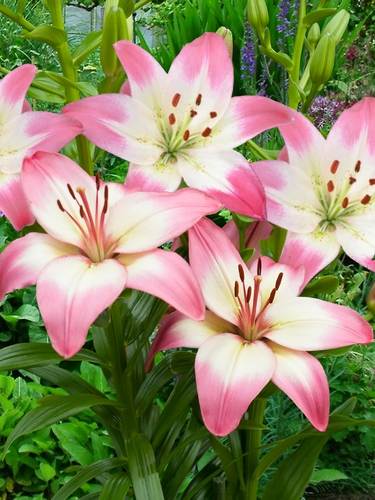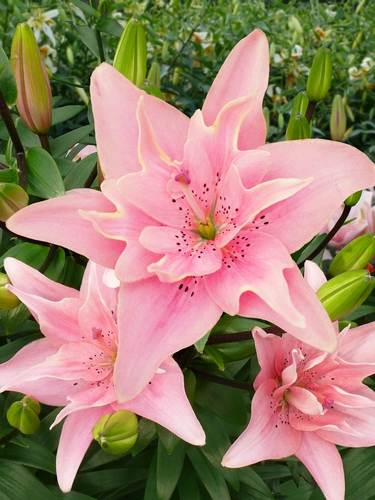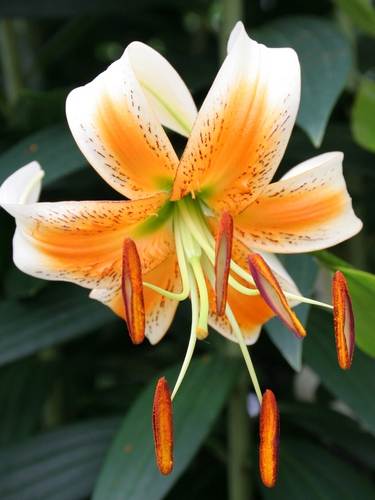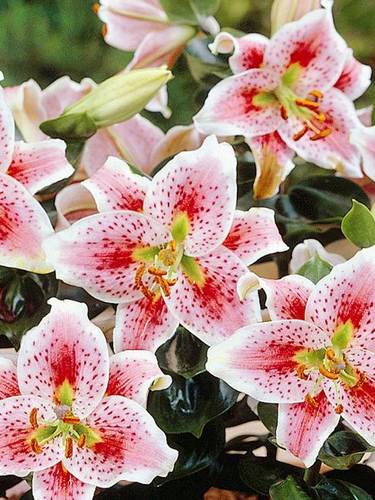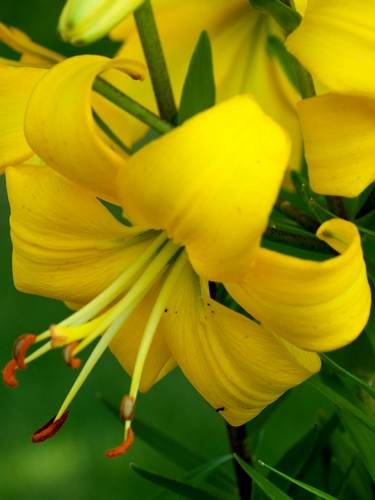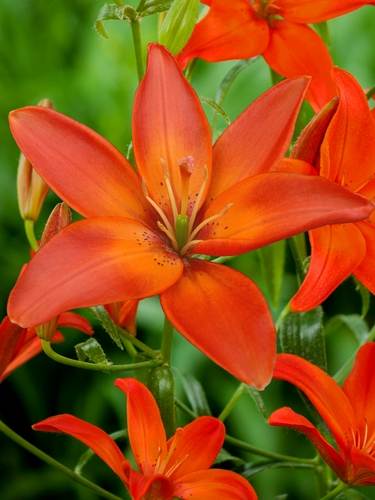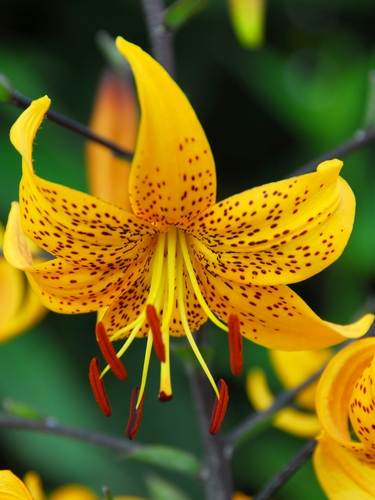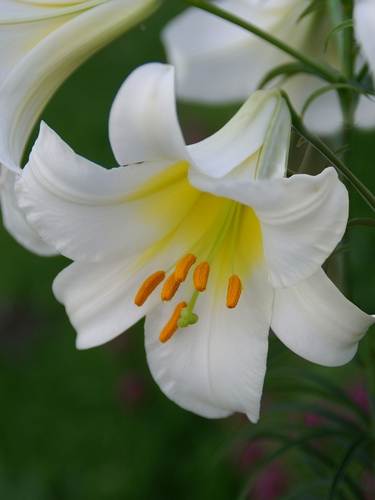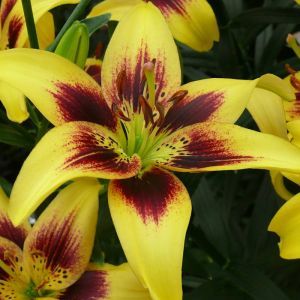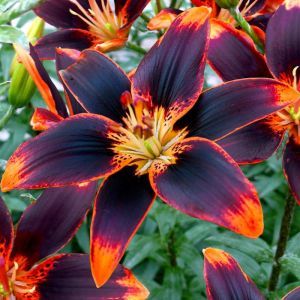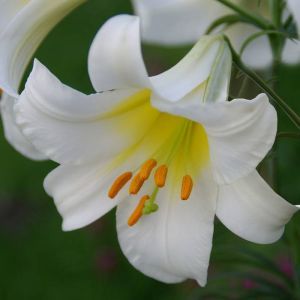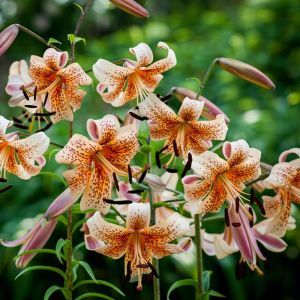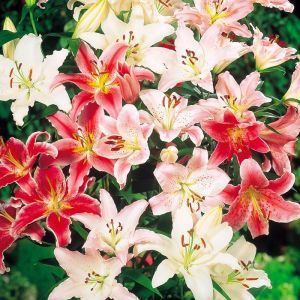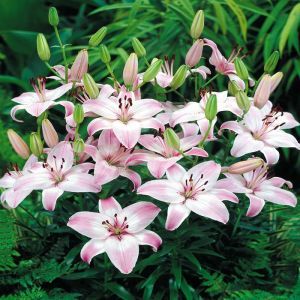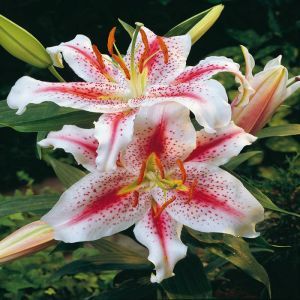Lilies
Lily bulbs are ideal for indoor flower arrangements
Quick Delivery Lilies - bold and beautiful, no garden is complete without at least one magnificent Lily. Lilies are available in a wide variety of stunning colours and shapes and many are wonderfully fragrant. Lily bulbs can be grown in borders, between shrubs or in patio containers.
Plant a few different lily varieties for fresh cut flowers all summer long, Asiatic Lilies are the first Lilies of the season to flower followed by Turks Cap Lilies, Aurelian Lilies and Tiger Lilies flowering mid summer and Oriental Lilies flower at the end of summer. Plant your Lily bulbs as soon as you get them.
Lilies are very easy to grow as long as they have good drainage, add some pebbles to the bottom of pots and grit to the soil if you are planting lilies in the ground. Plant the lily bulbs with the pointed tip of the bulb pointing upwards at a depth of about 3 times the size of the bulb deep.
How to Plant Lily bulbs in your garden
it is important to take the eventual height of the Lilies into consideration when you are planting them, if they are a tall variety they may need a sheltered spot with good wind protection. They will grow well in most Soil types but drainage is very important, if you don’t have good drainage then it is best to plant them on a slope, in a raised bed or in containers.
They like sun to semi Shade. Firstly plant your lily bulbs as soon as you get them. Remove all weeds from the planting spot. Prepare the planting area by using a firm Trowel, dig up the Soil to a depth of 3 times the width of the bulb and space them at least 2 times their width deep. Position the bulbs with the root base downwards (smallest part up wards) in the Soil and press firmly, cover the bulbs with the removed topsoil and cover with a layer of mulch. Water well after planting and mark the spot. Keep an eye out for the Newly emerging stems and support them with Bamboo canes if necessary.
Regularly check for Red lily beetles adults beetles and their larvae can completely devour an entire lily plant in a very short period of time. Inspect your New bulbs for signs of larvae before planting them and remove larvae by hand. Use Fresh compost to replant Lilies and dispose of compost if you have had any previous infestations. Chemicals can also be purchased from garden centres if all else fails.
How to Plant Lily Flowerbulbs in planters
Use a large planter, preferably a pot of approx 20 cm circ. and over even better. Put some pebbles at the bottom to ensure better drainage. Plant the lily bulbs halfway down the pot in a Soil mix of loam + coarse sand + compost. Fill up with the Soil mix and press down firmly, add some organic fertiliser on top of the Soil and water well. Place the planter on a sunny to semi shady location. As soon as the shoots appear you may need to stake them for to give some wind protection.
Keep a close eye out for the red lily Beetle as the can completely devour plants in a matter of days, remove them by hand, fortunately they are easy to catch, their grubs hatch underneath the leaves and eat the leaves of the plant.
After flowering you can plant the complete rootball in the border on a sunny to semi shady location, take care that the planting hole is big enough to take the rootball. They will re-appear as border Lilies next season.
For pot planting use the Asiatic Lily varieties and some of the Oriental Varieties such Mr. Sam and Muscadet.
Asiatic Lilies flower on very strong stems that rarely need staking
Hardy Asiatic Lilies are the first Lilies of the season to flower, they belong to the genus Lilium from fleshy bulbs.
Lilies come in a wide range of colours and sizes and are suitable for planting in gardens or containers.
Asiatic Lily bulbs are not fussy about soil as long as it drains freely. Plant lilies in groups for best results. Protect your lilies with a thick layer of mulch to help the soil retain moisture in dry weather and to keep the soil cool. Feed lilies fortnightly with tomato fertilizer.
Allow lily stems to die back naturally this will help the bulb to grow bigger and stronger for next year. Lily bulbs need to be dug up and divided every 3 or 4 years.
Aurelian Lilies produce beautiful large trumpet shaped flowers with long arching stamens
Their scent is so strong, in the evening the whole garden will be filled with their sweet fragrance.
Aurelian Lilies are mainly derived from hybridisation with the old Lilium Regale, which is in culture for many centuries and comes from the hill slopes of Sichuan China. The hybrids have the same characteristics as the old Regale Lily, they grow tall (100-125 cm) are fragrant and completely hardy.
Trumpet Lily Flower Bulbs are great for the border in combination with Perennial plants such as Nepeta as undergrowth
We supply many different Lily Flower Bulbs.
Martagon Lilies also known as Turks cap lilies
They originate from the hillsides and slopes of the Turkish mountains where they can be seen growing underneath pine trees in humus rich alkaline to neutral moist soil. Due to irrigation projects many of the Martagon lilies in the wild have lost their habitat.
Plant tMartagon Lilies in a semi shady spot under trees or between shrubs they look great at the edge of a pond. We have lovely Martagon lily flower bulbs and hybrids on sale.
Many other lily varieties are short lived but not this one Martagon Lilies will outlive them all they are self seeding and will spread over the years forming large carpets. Once planted Martagon Lilies need some time to develop roots, they don't like to be disturbed.
Oriental Lily bulbs are fantastic value as they will last for years
Oriental Lilies are great for growing in containers or in borders, they mix well with perennial plants, and are completely hardy they will re-grow easily next year.
Oriental Lilies are often fragrant and their flowers are a beautiful shape with edged and often mottled petals. The beautiful scent of Oriental Lilies will enhance your garden, particularly in the evening. Plant Oriental Lilies with your perennials and treat them as a perennial as they will re-appear over the seasons.
Oriental Lilies are completely hardy.
Pot lilies are ideal for a compact border and Pot and Tubs
These fine Lilies are hybrids selected for their dwarf growth. They will bring the beauty of Lily flower Bulbs to the all gardens and even balconies The bulbs are hardy and can be left in the ground where they will re-grow next season and flower against. T
hey come in strong colours and are highly decorative.
Plant Tiger Lilies in your border for maximum impact
Tiger Lilies or Lilium tigrinum species originally flowered with orange red, brown mottled, and arching back petals like a Turkish Cap Lily. The new Tiger Lilies strains however are hybrids with new colours and larger flowers.
Tiger Lilies are a real addition to the assortment, all very hardy with strong stems.
Lilly Bulbs: A Guide to Planting, Care, and Maintenance
Lilly bulbs are a popular choice for gardeners looking to add a touch of elegance and color to their gardens. These beautiful flowers come in a variety of colors and sizes, and they are known for their stunning blooms and sweet fragrance. With proper planting, care, and maintenance, lilly bulbs can thrive in gardens for many years.
Planting Lilly Bulbs
When planting lilly bulbs, it's important to choose a location that provides full sun to partial shade and well-drained soil. The ideal pH range for lilly bulbs is between 6 and 7, but they can tolerate a wider range of pH levels. Before planting, amend the soil with organic matter such as compost to improve drainage and fertility. When planting, be sure to plant the lilly bulbs at a depth of 2-3 times the size of the bulb, and water thoroughly.
Care and Maintenance
Lilly bulbs require regular watering, especially during dry spells. The soil should be kept consistently moist but not waterlogged. Fertilize lilly bulbs once a month during the growing season with a balanced fertilizer. Once the flowers have faded, cut the stems back to the base of the plant and remove the foliage. Lilly bulbs will produce more flowers if they are given enough time to rest and recover.
Common Problems
Lilly bulbs are generally hardy plants, but they can be affected by pests such as lily beetles and aphids, and diseases such as botrytis. To prevent these issues, make sure to provide proper care, including adequate watering and good air circulation. If you do notice pests or diseases, treat them promptly with an appropriate pesticide or fungicide. Regularly inspecting your lilly bulbs can help you catch any issues early on, making them easier to treat.
Benefits of Lilly Bulbs
Not only are lilly bulbs beautiful plants, they also have many benefits. They are easy to care for, and they attract pollinators such as bees and butterflies to your garden. They also make great cut flowers and can be dried for arrangements. They can add a touch of elegance to any garden or landscape and are a great addition to any garden enthusiast's collection.
In conclusion
Lilly bulbs are a beautiful and versatile addition to any garden. With proper planting, care and maintenance, lilly bulbs will thrive in your garden for many years. By following the tips and guidelines outlined in this guide, you will be able to enjoy the beauty of lilly bulbs in your garden for years to come.

